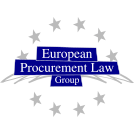About EPLG
The European Procurement Law Group was born in 2008 when a small group of public contract law experts decided to meet regularly to discuss relevant aspects of the law and practice in this area.
Members of the Group considered the comparative law approach to be both valuable and necessary in understanding how public procurement law is developed and applied – or misapplied – in the EU and in its Member States.
The methodology is the one that has been refined and perfected since the original small group of first met in Turin in 2008 to discuss of in house providing. There are 13 national chapters, written by scholars and practitioners from the 12 selected EU Member States and UK which are based on a questionnaire. Moreover, this volume is particularly rich with chapters addressing both general issues, such as joint cross-border procurement, the legal nature of CPBs and the procurement techniques they use, and comparative chapters based on the national chapters covering competition issues, remedies and the uninvited guest to our table, COVID 19 and its mutations. Moreover, given the specific topic, the editors were wise to secure some economic insight complementing our legal expertise.
We still stay true to our original idea: EU law needs comparative law! To us the comparative law approach is both valuable and necessary to understand how public procurement law is developed and applied – or misapplied – in the EU and in its Member States.
Both convergences and divergences send important signals to both EU and domestic law-makers, including the Court of Justice of the European Union. Comparative knowledge may inspire new approaches and help avoid mistakes in applying what are in the end the same principles and basic – and at times detailed – rules. Moreover, it is of value for practitioners in the Member States to be aware of practices, regulations, case law and interpretations of public procurement law throughout the EU, as this can assist them in both understanding the rules as applied in their own jurisdiction, and in developing best practices.
Furthermore, as the Court of Justice itself recalls on its official website, the courts of the Member States are courts of the EU as “the ordinary courts in matters of European Union law”. National courts and review bodies (where present) may, and in some cases must, refer questions to the Court of Justice. However, with more and more Member States having joined the EU and ensuing delays in the preliminary reference procedure under Article 267 TFEU, national courts and review bodies increasingly have to look elsewhere for best practices and possibly guidance. Precedents of national courts and review bodies of other EU Member States giving application to the same common EU rules should be a precious source of inspiration for those having to defend and decide public procurement cases.
The Court of Justice is aware of the comparative approach and some of its rulings are influenced by developments and trends in the regulation or practice of some Member States. Increased comparative knowledge of the case law of the Member States may alert the Court of Justice to the difficulties that national courts and review bodies are facing in giving full effect to EU law, including due to an insufficient understanding of the law as it is. The reference to a decision by the Danish Complaints Board for Public Procurement in Advocate General Wathelet’s opinion in Ambisig (Case C-46/15) is an obvious example of the value of dialogue between the Court of Justice and national courts.
The results of our meetings are published in the European Procurement Law Series.
Site created with the support of


